Ford Mondeo
Debut: 2007 |
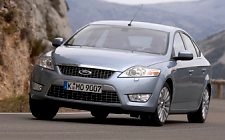 In
its hey day, the first generation Mondeo sold more than 600,000 units a
year worldwide. Fast forward to 2006, the second generation Mondeo sold
only 200,000 units. If we count only the sales in Europe, you will find
a similar trend: 376,000 units sold in 1994, 143,000 units in 2006. Why
the sales slide ? partly because the car came near the end of its life
cycle, but the main reason was a shrinking market segment. Not only
Mondeo, other mainstream-brand family saloons are also facing the same
problem – their market segment is gradually eaten up by compact premium
saloons (e.g. BMW 3-Series and Audi A4), MPVs, MAVs and pseudo
offroaders. So how does the third generation Mondeo respond to the
challenges? In
its hey day, the first generation Mondeo sold more than 600,000 units a
year worldwide. Fast forward to 2006, the second generation Mondeo sold
only 200,000 units. If we count only the sales in Europe, you will find
a similar trend: 376,000 units sold in 1994, 143,000 units in 2006. Why
the sales slide ? partly because the car came near the end of its life
cycle, but the main reason was a shrinking market segment. Not only
Mondeo, other mainstream-brand family saloons are also facing the same
problem – their market segment is gradually eaten up by compact premium
saloons (e.g. BMW 3-Series and Audi A4), MPVs, MAVs and pseudo
offroaders. So how does the third generation Mondeo respond to the
challenges? Observing the car from outside,
you will notice two things: first, it looks far more interesting than
the dull-looking second generation. Martin Smith's "Kinetic Design"
language injected a very sporty and aggressive theme to the new Mondeo.
The visual effect is quite striking, if not very elegant or time
resisting. Hopefully people will not refer Mondeo man to boring man
anymore. Observing the car from outside,
you will notice two things: first, it looks far more interesting than
the dull-looking second generation. Martin Smith's "Kinetic Design"
language injected a very sporty and aggressive theme to the new Mondeo.
The visual effect is quite striking, if not very elegant or time
resisting. Hopefully people will not refer Mondeo man to boring man
anymore. Another thing to catch your attention is the sheer size of the car. It looks significantly larger than the old Mondeo yet the visual effect tells only half the story – if not the sporty shape, it could look even larger. In fact, measuring 4844mm long, 1886mm wide, 1500mm tall and 2850mm in wheelbase, the new Mondeo is as large as a Volvo S80. No, it actually exceeds the big Volvo in most dimensions except the overall length. You might think the ghost of Granada Scorpio is reborn in the name of Mondeo. In fact, underneath the Mondeo is the same platform as Volvo S80. Ford utilized the EUCD platform developed by Volvo for use in new Mondeo and its sister car S-Max and Galaxy MPV. The high level of cost sharing allows the bigger Mondeo to be priced at the same level as before. All the three Fords are built in the Genk plant in Belgium sharing production lines and toolings. This strategy allows flexible allocation of production in case of changing demand. For instance, if the market continue to shift towards MPVs, more production capacity could be shifted to build S-Max and Galaxy and reduce the damage to the minimum. Vice versa, if greenhouse gas policy drive more MPVs back to sedans, Mondeo could absorb the excessive capacity of its MPV sisters. Clever. 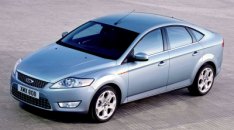 With an exterior size a class
larger than its rivals, the new Mondeo easily provides a class-leading
cabin space. No one complained the old car for short of rear passenger
space, but the new car is even more generous. It is the only car in its
class genuinely seat 5 tall guys comfortably. Its rear legroom exceeds
that of Volkswagen Passat by 15mm, Opel Vectra by 55mm and European
Honda Accord by almost 100mm ! Boot space is equally generous at 535
liters for the 4-door sedan. With an exterior size a class
larger than its rivals, the new Mondeo easily provides a class-leading
cabin space. No one complained the old car for short of rear passenger
space, but the new car is even more generous. It is the only car in its
class genuinely seat 5 tall guys comfortably. Its rear legroom exceeds
that of Volkswagen Passat by 15mm, Opel Vectra by 55mm and European
Honda Accord by almost 100mm ! Boot space is equally generous at 535
liters for the 4-door sedan. 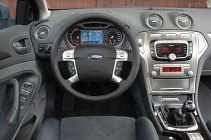 The
cabin design echoes the exterior – striking, flashy but too busy to me.
As you expect for a new sedan developed in Germany, Mondeo's cabin is
high quality and solidly assembled. Most surfaces are made of
soft-touch plastics, with the exception of the lower half where less
noticeable thus money can be saved. Only minor places and switchgears
reveal its quality ultimately not as high as Volkswagen Passat.
However, the driving position is excellent. The seats are comfortable.
The cabin is also full of kits. The most basic trim already includes
air-con, power windows, trip computer, cruise control and ESP. Upmarket
models get i-Pod / Bluetooth connectivity, touch-screen sat nav,
voice-recognition control, radar cruise control and HMI (Human Machine
Interface) control. The latter use a steering wheel-mounted control to
navigate menus displayed on the color screen at the instrument
binnacle. You don't need to turn your attention away from driving, so
it is more initiative and ergonomical than i-Drive, MMI or the like.
Equipment-wise, the new Mondeo sounds even more premium than BMW and
Audi ! The
cabin design echoes the exterior – striking, flashy but too busy to me.
As you expect for a new sedan developed in Germany, Mondeo's cabin is
high quality and solidly assembled. Most surfaces are made of
soft-touch plastics, with the exception of the lower half where less
noticeable thus money can be saved. Only minor places and switchgears
reveal its quality ultimately not as high as Volkswagen Passat.
However, the driving position is excellent. The seats are comfortable.
The cabin is also full of kits. The most basic trim already includes
air-con, power windows, trip computer, cruise control and ESP. Upmarket
models get i-Pod / Bluetooth connectivity, touch-screen sat nav,
voice-recognition control, radar cruise control and HMI (Human Machine
Interface) control. The latter use a steering wheel-mounted control to
navigate menus displayed on the color screen at the instrument
binnacle. You don't need to turn your attention away from driving, so
it is more initiative and ergonomical than i-Drive, MMI or the like.
Equipment-wise, the new Mondeo sounds even more premium than BMW and
Audi !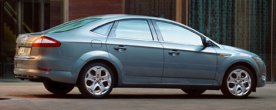 The same goes for driving
refinement. This is another major improvement of the new Mondeo. Its
monocoque chassis is 130% stiffer than the old car. Its MacPherson
struts and Control-Blade multi-link suspensions are mounted to the
chassis via fluid-filled bushings to suppress NVH. The sound insulation
is also thoroughly upgraded. On motorway, no other cars in the class,
including the small BMW and Audi, cruises so relaxingly, with so little
wind and road noise heard in the cabin. The ride quality is also a
triumph. Few cars with passive suspensions can deal with broken back
roads and high-speed bumps equally well like this one. Moreover, the
new Mondeo offers continuous adaptive damping and 3 driving modes
(Normal, Sport and Comfort) as option. But even on the standard
suspensions the Mondeo is already a very comfortable yet surefooted
ride. The same goes for driving
refinement. This is another major improvement of the new Mondeo. Its
monocoque chassis is 130% stiffer than the old car. Its MacPherson
struts and Control-Blade multi-link suspensions are mounted to the
chassis via fluid-filled bushings to suppress NVH. The sound insulation
is also thoroughly upgraded. On motorway, no other cars in the class,
including the small BMW and Audi, cruises so relaxingly, with so little
wind and road noise heard in the cabin. The ride quality is also a
triumph. Few cars with passive suspensions can deal with broken back
roads and high-speed bumps equally well like this one. Moreover, the
new Mondeo offers continuous adaptive damping and 3 driving modes
(Normal, Sport and Comfort) as option. But even on the standard
suspensions the Mondeo is already a very comfortable yet surefooted
ride. Then what about handling – the traditional strength of Mondeo ? As the car is much wider and heavier, inevitably it becomes less nimble and less agile in tighter roads. Sadly, it has lost a little athletic character of the last two generations. However, the new Mondeo is still a highly inspiring driving machine. Its steering is still well-weighted, precise and feelsome, thanks to the persistence in hydraulic power steering. Its positive gearchange and responsive brakes still encourage you to push it. It still slices accurately into corners. Its body control and high-speed stability are better than ever. In short, it is the most entertaining drive in its class bar Peugeot 407. 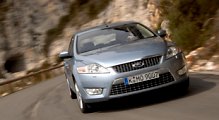 Comparatively,
performance is only average. Ford offers 5 petrol engines (1.6 Duratec
110hp, 1.6 Duratec VVT 125hp, 2.0 Duratec HE 145hp, 2.3-liter Duratec
HE 161hp and Volvo's 2.5-liter 5-cylinder turbo with 220hp) and 2
diesel engines (1.8TDCi 125hp and 2.0TDCi 140hp). None of them are
really new and none of them are world-beating engines. The 145hp
2.0-liter petrol used to be a big seller in the old Mondeo, but
unfortunately it is not punchy enough to cope with the heavier new car.
To deliver decent performance, you need the 140hp 2.0TDCi with 6-speed
gearbox. If budget allow, the best choice is the Volvo 5-pot engine, of
course. Its extra performance (152mph top speed and 0-60 mph in 7.1
seconds), smoothness and lovely sound worth the extra money, although
higher fuel consumption and emission tax will be harder to swallow. Comparatively,
performance is only average. Ford offers 5 petrol engines (1.6 Duratec
110hp, 1.6 Duratec VVT 125hp, 2.0 Duratec HE 145hp, 2.3-liter Duratec
HE 161hp and Volvo's 2.5-liter 5-cylinder turbo with 220hp) and 2
diesel engines (1.8TDCi 125hp and 2.0TDCi 140hp). None of them are
really new and none of them are world-beating engines. The 145hp
2.0-liter petrol used to be a big seller in the old Mondeo, but
unfortunately it is not punchy enough to cope with the heavier new car.
To deliver decent performance, you need the 140hp 2.0TDCi with 6-speed
gearbox. If budget allow, the best choice is the Volvo 5-pot engine, of
course. Its extra performance (152mph top speed and 0-60 mph in 7.1
seconds), smoothness and lovely sound worth the extra money, although
higher fuel consumption and emission tax will be harder to swallow.Theoretically, the new Mondeo can fit Volvo's forthcoming T6 turbocharged straight-6 engine. However, this is unlikely to happen because Ford understands the market positioning of Mondeo. The winning formula of new Mondeo is offering premium car level of space, quality, refinement and high-tech toys at bread-and-butter price. At the same time, it does not sacrifice driving excitement that always associated with the name Mondeo. Ford sets a new standard for mainstream family cars. It deserves every success ! |
| The above report was last updated on 4 May 2007. All Rights Reserved. |
| Specifications | ||||||||||||||||||||||||||||||||||||||||||||||||||||||||||||||||||||||||||||||||||||||||||||||||||||||||||||||||||||||||||||||||||||||||||||||||||||||||||||||||||||||||||||||||||||
|
||||||||||||||||||||||||||||||||||||||||||||||||||||||||||||||||||||||||||||||||||||||||||||||||||||||||||||||||||||||||||||||||||||||||||||||||||||||||||||||||||||||||||||||||||||
| Performance tested by: - |
Copyright©
1997-2010
by Mark Wan @ AutoZine
 The
Mondeo Mk3 has always been a good looker, but after 3 and a half years
on the market it starts showing its age. It must be said that 90
percent of its design still looks good. The only part needs updating is
its nose, which looks a little bit bland. In the facelift, Ford slims
up the upper grille and enlarges the lower grille, making the nose more
aggressive and 3-dimensional. The latter is also helped by a curvier,
more pronounced clamshell bonnet. Above the redesigned fog lamps are
LED daytime running lights. These styling tweaks should be enough to
carry the Mondeo through its remaining life.
The
Mondeo Mk3 has always been a good looker, but after 3 and a half years
on the market it starts showing its age. It must be said that 90
percent of its design still looks good. The only part needs updating is
its nose, which looks a little bit bland. In the facelift, Ford slims
up the upper grille and enlarges the lower grille, making the nose more
aggressive and 3-dimensional. The latter is also helped by a curvier,
more pronounced clamshell bonnet. Above the redesigned fog lamps are
LED daytime running lights. These styling tweaks should be enough to
carry the Mondeo through its remaining life.